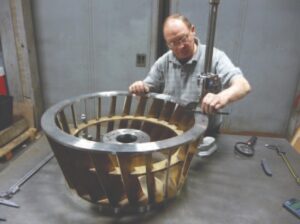 Hosokawa Micron powder-classification equipment and how particle density affects it
Hosokawa Micron powder-classification equipment and how particle density affects it
August 16, 2022 REDWIRE is news you can use from leading suppliers. Powered by FRASERS.
Posted by Firing Industries Ltd
The business objective of FIRING INDUSTRIES LTD. is to consult with clients to select and supply technically complex PRO... Read more
Subscribe
Free REDWIRE e-newsletter

Powder-classifying machines are available from Hosokawa Micron.
Firing Industries Ltd. teams up with Hosokawa Micron to supply numerous industrial processing solutions, such as equipment for dry-powder classification. A variety of technologies is used in bulk-solids classifying machines, and their effectiveness depends on material characteristics, the target particle size, and how the material is going to be used.
Particle density greatly influences dry-powder classification. Sometimes, material particles are uniform in size, but vary in density, which affects the performance of these Hosokawa Micron machines.
Cyclones and elutriation/dynamic classifiers
When some particles are heavier than others are, screeners cannot classify the material, as particles fit through the same-sized screen openings and stay mixed. So different classification machines are necessary to separate material based on particle density.
One line of Hosokawa Micron solutions available from Firing Industries is cyclones. These use vortex airflow to separate material into coarse and fine fractions. Cyclones are highly economical solutions for many classification tasks, safely and efficiently handling many materials with consistent production yields. Each delivers a 95 per cent collection efficiency when classifying particles sizes larger than ten microns. Dimensions, outlet-tube diameter, air velocity, material load, and other parameters determine cut point and collection efficiency.
Elutriation classifiers function according to Stokes’ Law, which expresses the settling velocity of small spherical particles in a fluid medium. They use this force relationship to separate low-mass or low-density particles from high-density or high-mass ones. Users can control which particles rise and fall to determine the cut point by adjusting the opening parameters. Elutriation can have problems classifying particles with a uniform size yet different densities, or uniform particle size yet different surface areas. These classifiers work best for particles sized from 0.3 to ten millimetres that, due to varying characteristics, cannot be sieved effectively,
Dynamic air classifiers by Hosokawa Micron are units that use the principles of elutriation, drag force, and centrifugal force to separate materials into fine and coarse fractions. These machines classify a wide variety of material with particle sizes from three to 100 microns, achieving high production yields and efficiencies.
To learn more, contact Firing Industries’ application-sales engineers at ddubuc@firing.com or (877) 688-0974.
Share
Posted by Firing Industries Ltd
The business objective of FIRING INDUSTRIES LTD. is to consult with clients to select and supply technically complex PRO... Read more
